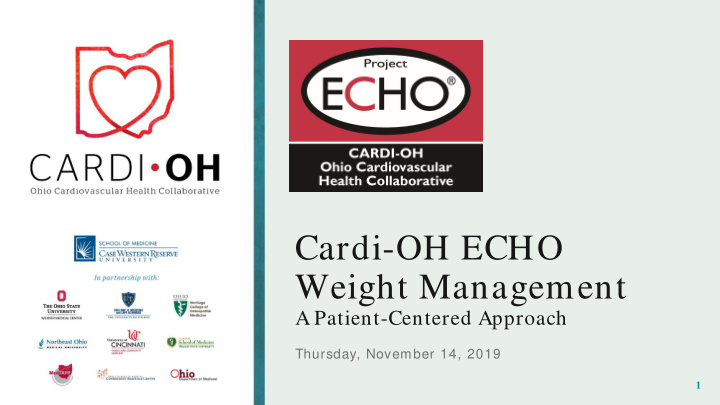



Cardi-OH ECHO Weight Management A Patient-Centered Approach Thursday, November 14, 2019 1
Disclosure Statements The following planners, speakers, moderators, and/ or panelists of the CME activity have financial relationships with commercial interests to disclose: • Adam T. Perzynski, PhD reports being co-founder of Global Health Metrics LLC, a Cleveland- based software company and royalty agreements for forthcoming books with Springer publishing and Taylor Francis publishing. • Siran M. Koroukian, PhD received funds for her role as a site PI on a subcontract with the Cleveland Clinic. • Christopher A. Taylor, PhD, RDN, LD, FAND reports grant funding and travel support for his role as a consultant, researcher, and presenter for Abbott Nutrition, and is also a member of the Scientific Advisory Council of Viocare, Inc. • These financial relationships are outside the presented work. All other planners, speakers, moderators, and/ or panelists of the CME activity have no financial relationships with commercial interests to disclose. 2
Obesity and the built environment Goutham Rao, MD Chief Clinician Experience and Well-Being Officer, University Hospitals Health System Jack H. Medalie Endowed Professor and Chairman Department of Family Medicine and Community Health Division Chief, Family Medicine, Rainbow Babies and Children’s Hospital Case Western Reserve University School of Medicine & University Hospitals of Cleveland 3
Objectives • Define the built environment. • List and define different levels of measure of the built environment. • Explain the influence of the built environment upon body weight. 4
The Built Environment • Environment: “All that is external to the individual.” • Built environment: “Encompasses aspects of a person’s surroundings which are man made.” • Broad definition: • Schools, cities, workplaces • Community-based practices • Restaurants/ grocery stores 5
6
7
8
9
Levels of Measurement 10
Is a healthier built environment associated with lower levels of obesity? 11
12
13
14
Wall Street Journal 6/ 29/ 2007 Bison Don't Roam , And I t's a Problem For the Polish Herd Plan I s to Get Lazy Beasts To Travel Abroad and Breed; The EU Looks for Solution 15
The Built Environment • Difficult to study. • Conflicting results. • For example, two studies report higher obesity rates in communities with higher fast food density; two others do not. 16
Access to Physical Activity • Proximity to play space/ recreational facilities • No relationship in young children • Positive association of overweight with distance among adults • Net residential density • Greater the density, less the risk of having overweight • Land use mix • Greater land use mix, less the risk of having overweight • Neighborhood walkability • Greater walkability, less the risk of having overweight • Number of recreational facilities • Higher the number of facilities, the less the risk of having overweight • Sprawl/ Commuting time • Mixed results. Generally associated with increased risk of overweight 17
Access to Food Sources • Supermarkets • Lower risk of overweight • Concept of food deserts being cast in doubt http:/ / w w w .nytim es.com / 2 0 1 2 / 0 4 / 1 8 / health/ research / pairing-of-food-deserts-and-obesity-challenged-in- studies.htm l?_ r= 0 • Convenience stores • Increased risk of overweight • Fruit and vegetable prices • Predicted lower gains in BMI among children over 3 year period beginning at age 4 or 5 18
The Built Environment • Uses a different language: • Density: “amount of activity in an area” • Diversity: “diversity in the spatial arrangement of land use” • Connectivity: “ease of travel between places.” • Design: “features of individual streets or structures.” • Spatial access: “intensity of the possibility for interaction” 19
The Built Environment • Challenges • “Place” • “Context” • “Endogeneity”: Bias through neighborhood selection by residents) 20
Environmental Obesogens • Bisphenol A (BPA) • Organotins (TBT) & TPT • Perfluorooctanoic acid (PFOA) • Phthalate • Phytoestrogens 21
Bottom Line • Conclusive evidence for the role of obesogens in promoting obesity is lacking. • Regulating environmental obesogens may be a wise thing to do, but as an obesity-control measure, it should be a very low priority. 22
What should we do? • 2005 Institute of Medicine Report on Childhood Obesity: • “Knowing that it is impossible to produce an optimal solution a priori, we more appropriately adopt surveillance, trial, measurement, error, success, alteration, and dissemination as our course, to be embarked on immediately. Given that the health of today’s children and future generations is at stake, we must proceed with all due urgency and vigor." 23
Elements of Safe Routes to School Programs • Education • Encouragement • Enforcement • Engineering • Evaluation 24
Evaluation Is the program making a difference? 25
Moving Ahead for Progress in the 21 st Century (MAP-21) • Legislation passed in 2012 • Established new program: Transportation Alternatives • SRTS activities eligible to compete for funding • States transitioning to new legislation • Many states have SAFETEA-LU More Information: funds remaining www.saferoutesinfo.org 26
27 27
Where should we invest our advocacy efforts? • Safe routes to school • Promoting healthier workplaces • Promoting healthy beverage consumption 28
Thank you! Questions/ Discussion 29
Registration is Open! Spring 2020 teleECHO Clinic: Reducing the Burden of Hypertension Thursdays, 8-9 AM, January 16 – April 2, 2020 https: / / www.cardi-oh.org/ echo/ hypertension-spring-2020 30
Watch Previous ECHO Clinics Register with Cardi-OH and watch all ECHO Weight Management Clinics https: / / www.cardi-oh.org/ user/ register https: / / www.cardi-oh.org/ echo/ weight-management-fall-2019 31
Reminders • A Post-Clinic Survey will be emailed to you. Please complete this survey as soon as possible. • The MetroHealth System is accredited by the Ohio State Medical Association to provide continuing medical education for physicians. • The MetroHealth System designates this educational activity for a maximum of 1 AMA PRA Category 1 Credit(s)TM. Physicians should only claim credit commensurate with the extent of their participation in the activity. 32
Recommend
More recommend